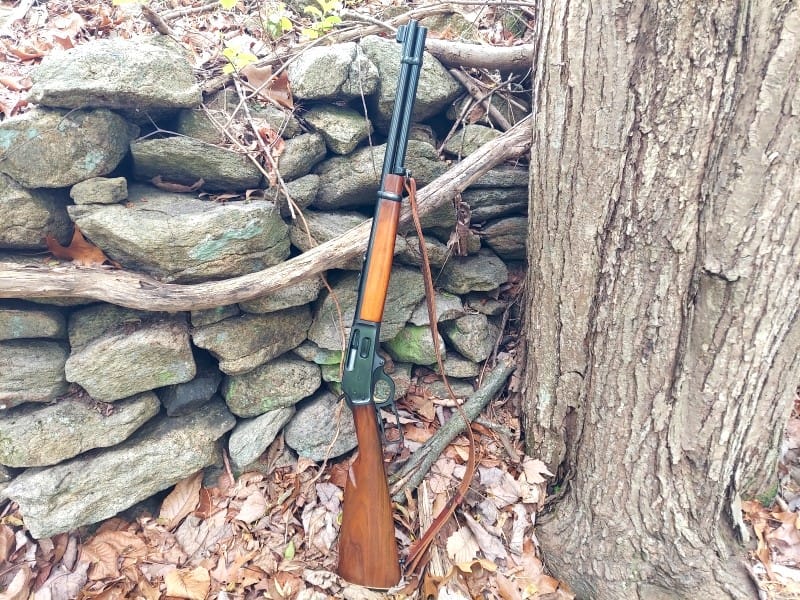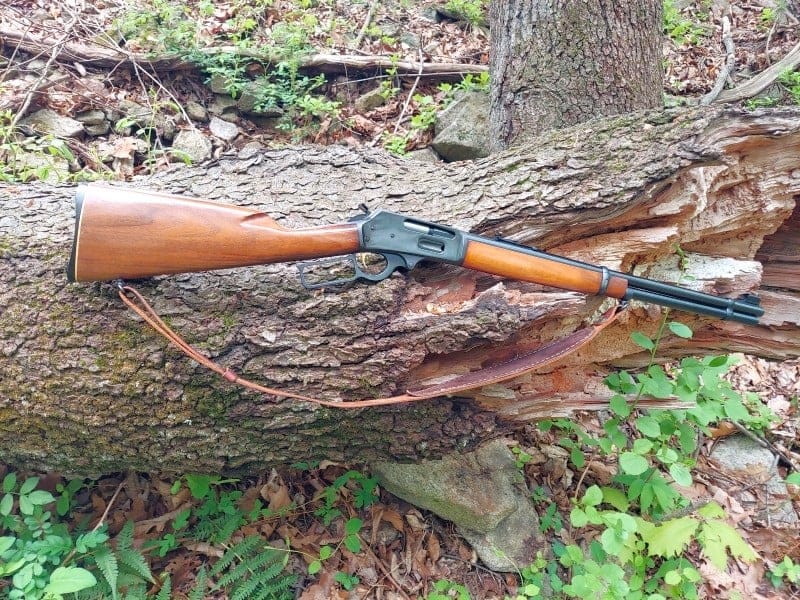A Classic Marlin 336: .30-30 Goodness

When Marlin closed their doors, it was huge news in the shooting community. It was a sad day. In September 2020, though, Ruger purchased the Marlin company and began to resurrect it from the ashes. All of this drama made a huge splash. Currently, Ruger is manufacturing a number of Marlin lever actions, and they seem to be doing a splendid job of it. They’re even bringing back the Marlin 336 now!
While everyone is buzzing about Ruger’s venture producing new Marlins, the aim of this article is to take a look at the older, classic Marlin 336. We’ll be taking a look at the roots of the old Marlins.
History of the Marlin 336
Marlin’s Model 1893 rifle was produced from 1893 to 1936. In 1936, some minor changes occurred, and the Model 1893 became the Model 36. Both of these rifles featured side ejection, unlike their major competition, the Winchester Model 94 (1894).
Marlin’s Model 336 was introduced in 1948, replacing the Model 36. To say that the Marlin 336 is popular is an understatement; more than six million have been produced. That makes it not only one of the most popular rifles in the United States but in the entire world.
The 336 has been offered in barrel lengths ranging from 16 to 24 inches. Over the years, it was offered in a wide array of calibers. These include: .30-30 Winchester, .35 Remington, .32-40 WCF, .32 Special, .338 Marlin Express, .356 Winchester, .375 Winchester, .38-55 Winchester, .44 Magnum, .444, .410, and others. By far, the .30-30 is the most popular and prevalent.
It seems that the majority of grip stocks on the Model 336 have been the curved pistol grip, but the one for our article has a straight stock.
Details
The Marlin 336 has a round bolt that contributes to both strength and extremely smooth and fast-operating action.
Beginning in 1956, the receivers were drilled and tapped for easy mounting of telescopic sights. An offset hammer spur was also included to make it easier to cock the hammer when a scope is mounted.
This is a huge reason why the Marlin 336 has a distinct advantage over the Winchester Model 94 (1894); the Winchester ejects its empty casings from the top of the receiver. That makes mounting a scope on the Winchester next to impossible; the empty casings cannot properly eject because they hit the scope that is located directly above the ejection port.
In the 20-inch barrel version, the rifle is 38.5 inches long and weighs approximately seven pounds. The under-barrel, tubular magazine holds six rounds, plus one in the chamber. Feeding is via a side loading gate, so the magazine can be topped up as the shooter fires, should he or she desire.
Unlike other lever actions, the Marlin 336 is easy to take apart, requiring only a screwdriver. The bolt can be removed quickly, allowing the barrel to be cleaned from the breech end, rather than the bore. Cleaning a rifle from the bore can cause damage to the bore/crown area, which affects accuracy. The 336 avoids that.
The fit and finish on the older Marlins have always been excellent, and the subject of this article is no exception. Despite having weathered countless hunting seasons, it’s still in fine shape. As mentioned, this particular 336 was made in 1973, confirmed by its serial number. The wood stock still has a nice finish, though it has many little dings here and there — little scars from its many outings in the field.
It nimbly jumps to the shoulder and it’s easy to get a proper, fast cheek weld on the stock. With the 20-inch barrel, it balances so well.
The Lever Action Tradition
Being Eastern PA whitetail hunters, we were not at all unique in choosing .30-30 lever actions as our deer rifles. In fact, when I was a kid (back when the earth was cooling and the sun was still 60 watts), the vast majority of people whom we knew used the venerable .30-30 for hunting. I’ve often joked that it’s “standard issue” for PA deer hunters.

The truth is that, when we’re out in the woods, the majority of shots we’d be able to take advantage of occur within 100 yards. And among those, a good percentage more are in the 20-50 yard range. For such hunting, the .30-30 lever gun is absolute perfection.
.30-30 Cartridge
The .30-30 cartridge was born in 1895 and was one of the first cartridges to use smokeless powder. The roughly 2,000 feet per second muzzle velocity was considered pretty zippy for the time period. Teddy Roosevelt was a big fan of the old “Thutty-Thutty.”
Most of the rounds available are in the 150 to 170-grain weight class, which are well suited for taking deer. The heavier rounds are even effective on black bear, some of which inhabit the region.
Although I can’t find official statistics on it, I’ve often heard that the .30-30 has taken more deer and other game than any other round in history. And when you look at how long it’s been around, and how many people use it, it would be difficult to refute that argument. Think about it…over six million Marlin 336 rifles have been produced, along with 7.5 million Winchester Model 94s. Not all of these have been in .30-30, but a huge percentage of them have been. That’s a lot of .30-30 rifles floating around out there.

I’ll take a minute to underscore my point here. Consider all the very high-velocity, flat-shooting rounds that are available these days. They’re way too numerous to list in their entirety, but a few are the various 7mms, including the Magnums. The .243, .270, .280, .30-06, the .300 Magnum…the list goes on and on. And yet, people can’t get enough of the .30-30 lever action rifle.
Don’t believe me? Try finding one on the shelves these days. I dare you. Especially Marlins, since Marlin had closed up shop. Prices have risen well above $1,000, and frequently, well above $2,000, depending on where you’re looking. Despite many better long-range options, the .30-30 is selling like brownies at a group meeting.
Around my locality, any gun shop that sells ammunition will have .30-30 Winchester ammo on hand. That availability means a lot.
Why is the lever action so popular?
Why the popularity? As best I can figure, it’s two-fold:
- Tradition.
- Re-Discovery.
I’ll explain. Tradition, because our fathers and their fathers (and their fathers) used them for over a century to hunt with. The lever action is the quintessential “Cowboy Gun” seen in so many Spaghetti Westerns from our childhood. Even today, people love a good Western movie. There’s just something about using a rifle designed in the 1800s, with a cartridge to match, to hunt with today. Many of us just think it’s a neat idea. And it works just as well today (better, in fact, given the advances in powder and bullet technology, not to mention optics) as it did way back when.
As for Re-Discovery, we tend to repeat trends. We “re-discover” something that was right in front of us. Re-inventing the wheel, if you will. Look at the lever action carbine courses popping up around the country. We’ve come back to our roots, in that people are realizing all over again, how handy the lever action is at hunting and defense. It’s short, relatively light, handy and maneuverable, and powerful enough to get the job done.

Yes, there are some lever actions that now employ rail systems, are all black, and have scopes, lasers, red dots, sound suppressors, and all manner of gadgetry bolted onto their frame, nearly making them crew-served weapons. If that’s your twist, by all means, have at it. But there’s just something about that lever action that keeps drawing us back. The action can be run fairly quickly. With a side loading gate, they can be loaded quickly enough, too. Most .30-30s hold six rounds, with the pistol caliber iterations holding a lot more than that, usually.
The old lever gun looks much less threatening than most semi-autos, as well, which equates to fewer people being terrified at the sight of it. And possibly fewer legal issues, should we be forced to defend ourselves with one.
No wonder it’s such a popular truck gun. And goodness knows how many people have one by the bedside or propped behind the door, “just in case.”
Back To Yester Year
While newly produced rifles bear wonderful fit and finish and are every bit as effective as the older rifles, there’s just something about the older production rifles (not just Marlin, but most manufacturers) that is special. They’re just not made this way anymore. When you hold an older rifle, it has a special feel to it, a certain quality. I can’t quite put my finger on it, but they’re just…different. Perhaps other readers feel the same way when hefting an older firearm. They’re definitely from an era of days gone past.
The particular Model 336 for this article was the rifle that my dad used for years when we hunted white-tail deer in the woods of Eastern Pennsylvania.

It has seen some extreme weather. I recall one year when we were out in freezing rain on a mountaintop while deer hunting. It was so cold that the rain was freezing on everything, including us and our rifles! Occasionally, we had to crack open the actions on our lever guns to keep the parts moving so that they wouldn’t freeze solid.
That might be the coldest I’ve ever been in my life. My toes and fingers stung something fierce! We pressed on, though, and we saw the biggest buck of our lives. This deer’s rack was enormous, extending out to the sides and up above his head like nothing we’d ever seen. He was pretty far off and before we could get in position for a shot, another hunter spooked him off. For years afterward, we spoke in awed whispers about that buck!
Certainly, there are many memories attached to this rifle. Cold fall mornings when the leaves crunched underfoot as though they were protesting the frigid temperatures and the frost that covered the ground. Or the many opening days of hunting season, most of which seemed to be fraught with rain and/or sleet. Hours spent trying to silently stalk along woodland paths in the dark, avoiding the crunching, dry leaves and twigs that snapped, which would alert the deer that we were coming.
Fond memories of days gone past, spent with my dad in the woods. Those days are gone now, and so is my dad. This rifle that he carried is a tangible reminder of those times. It’s funny how an item can bring back memories like that. When I look at this Marlin 336, I don’t just see the rifle — I see all of those memories flooding back like a huge collage in my mind.
Mostly, though, I see my dad and it reminds me of how much I miss him.
The post A Classic Marlin 336: .30-30 Goodness appeared first on The Mag Life.


